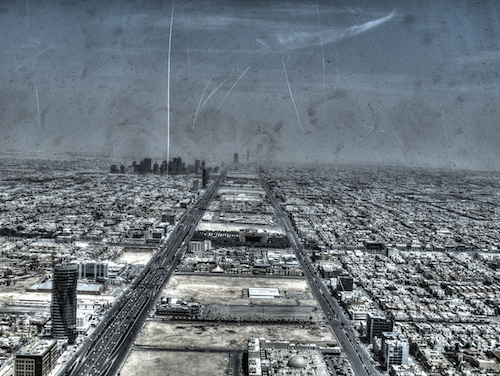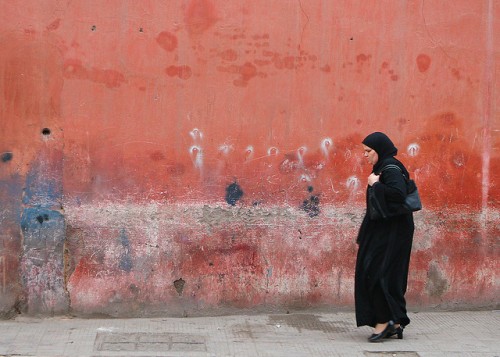We had been living in Riyadh for all of a week or two when Joyce and I decided to take in a day of shopping at the glorious Faisaliah Mall.
In Saudi Arabia, socializing with friends and family over a meal and spending the evenings out shopping are two of the most popular pastimes, so it is no wonder that the capital city is festooned with innumerable opportunities to do both.
We both adjusted very quickly to these local customs and it became our habit to spend Thursday mornings perusing the latest sales at one of the malls and then enjoying a lunch together before returning home.
On one such excursion, we were strolling along while waiting out the Dhuhr prayer time. Hundreds of other shoppers similarly spent the half-hour either eating their lunch in the food court, chatting on one of the many wooden benches or in one of the special prayer areas provided by the mall.
During those early days, the sight of all humans clothed entirely in black abayas or white thobes was still a marvel to us and we were often taken aback by some of the ritualistic behaviors practiced during the five holy times of the day.
Performing wudhu, (or ablutions) are a prerequisite to prayer and we had been startled on more than one occasion to enter a public washroom and find two or three ladies with their voluminous skirts and abayas hoisted above their knees as they washed their bare feet in the sink.
Apparently, our rather conventional Canadian outlook on hygiene etiquette needed a little more acclimation time than did our ability to shop with the best of them.
As we moved down the mall, I noticed a woman kneeling in the alcove of a shop; pressing her forehead on the cool marble floor as she prayed. What was particularly striking to me was that the place she had chosen to worship was in the entrance-way to the very popular shoe store, Nine West.
The juxtaposition of this devout Middle Eastern lady saying her prayers below the neon signage of this ubiquitous American shop struck me rather forcefully and it occurred to me that had I a camera at the ready, this image would make a rather provocative magazine cover.
Taking the Wheel
The patriarchal tradition in Saudi Arabia has created a very interesting aspect to life here.
In Canada, it is still the norm to see mostly mothers accompanying their children to doctor’s appointments or dropping them off at school each day. Due to the fact that women here are not permitted to drive, the fathers are assigned that role by default.
It still intrigues me to see the prevalence of men with one or more little ones in tow as they make their way down the corridors of the hospital or stopping in at the local supermarket after their work day and cruising the fruit and vegetable aisles with carts piled high with food.
Alarmingly, on a handful of occasions, I have actually witnessed a boy-child barely able to see over the dashboard, chauffeuring his mom or sisters about on their errands.
Which raises the issue of women drivers in the Kingdom of Saudi Arabia.
While I very quickly acknowledge that in smaller cities or in more rural areas, women driving cars is a perfectly natural and practical notion, the idea of driving in Riyadh immediately creates a visceral response deep within my body, akin to the feeling one might have if teetering on the edge of a very steep cliff.
Navigating the streets of this city either on foot or behind the wheel of a car is an exercise in courage, constant vigilance and patience like no other.
Densely populated centres such as Rome or London probably convey more cars on their roads per day, but there still seems to be some sense of predictability to their chaos in traffic.
The drivers may indeed be aggressive, but for the most part they adhere to some basic rules of the road. Here, the myriad driving violations are never-ending, completely random and often committed at high speeds. The use of turning indicators is almost non-existent, while the use of the horn is incessant and many cling to the belief that it is their inherent right to turn left or right at an intersection from the third or fourth lanes over.
It behooves every driver to continually assess and adjust at an unrelenting pace and sadly, Saudi Arabia ranks very highly on the global scale of motor vehicle fatalities.
(On a personal note, I have held a Canadian driver’s license since the age of 16, but I can honestly say that I have absolutely no desire to drive a car here.)
This does not however, address the deeper philosophical question of whether or not women should be permitted to drive in Saudi Arabia.
As may be expected, my immediate western-oriented answer is in the affirmative, but when I posed the question to my female Saudi colleagues, their response were unified. They each echoed my concern at the lack of driving education and agreed that the profusion of testosterone on the city streets creates an extremely dangerous arena for the uninitiated motor vehicle operator.
Perhaps not surprisingly, as women who have grown up with either a male relative or a hired taxi ferrying them from door to door in an air-conditioned vehicle, the idea of driving themselves around in Riyadh is not a priority for my friends.
Far more relevant to them would be a change in the practice of having to seek a male relative’s approval for almost every significant decision they are faced with throughout their lives. Understandably, being granted the ability to drive somehow takes a back seat to their desire for a release from this rather more profound restriction on their autonomy.
Thinking it Through.
When in public, all women in the Kingdom of Saudi Arabia are required to wear a black, loose fitting and fully concealing garment known as an abaya over their clothing.
As Muslims, the women here also cover their hair with a hijab (scarf) and many of the more conservative ladies will by choice, veil their faces with another black cloth, called a nikab. A few women even don black gloves in order to shield all visible skin from the view of males.
For years, this form of “covering” has raised the ire of many people the world over, but interestingly, along with followers of Islam, many other women of faith including Christians, Jews, Hindus and Mennonites have and do, dress very modestly and cover their hair as part of their faith.
Being the curious soul that I am, I have chatted many times with my female Saudi colleagues regarding this issue. Each of the five that I work with is in their mid to late twenties. Two of them cover their faces and have articulated very clearly that they do not want to remove their nikabs in public—being without it makes them feel vulnerable, uncomfortable and it is their strong belief that they should cover.
I arrived in the Kingdom without a lot of preconceived notions of how people here should or should not conduct themselves.
I understood it to be an extremely conservative country, steeped in tradition and customs that penetrate all layers of society, but I tried to reserve judgment until I could arrive at some conclusions firsthand.
Paramount in my mind was the concept that, just as I expect people to respect the rules and mores when they visit my country of Canada, I should endeavor to do the same when I travel. It was always very clear to me that I was here by choice and that if I felt unable to stay in such a restrictive land, rather than being bitter about my circumstances, I should simply choose again to return from whence I came.
Conversations with my friends at work have revealed some interesting truths and remind me yet again not to impose my ideas of what is “normal” on an entire people for whom other customs are their norm.
Wearing the abaya is as natural to the ladies in this country as donning a coat on a chilly day is to us in Canada. The wearing of abayas and hijabs commences at puberty and just as other societies celebrate their own rites of passage that signify the transition from a little girl to a young lady, these outward trappings of “womanhood” are looked forward to with some anticipation.
It is important to note that when everyone around you is doing the same, a particular practice such as this is probably not viewed as a hardship—rather it’s a natural way of life.
In his book, “David and Goliath,” author Malcolm Gladwell refers to this phenomenon as “The law of relative deprivation,” whereby people usually compare themselves to others who are within the same situation as they are.
Simply put, how you see yourself in relation to others in your immediate circles determines how positively or negatively you feel about your circumstances. If all the women in your home, city and country also wear an abaya in public, you would probably not see your requirement to wear one as anything unusual.
Fun, Food and Family.
The importance of family ties and values is sacrosanct to the people of this country and is evident at every level. Friday, the holiest and most anticipated day of the week, is invariably reserved for worship and time spent with relatives. In the hospital setting, it is truly heart-warming to see the concern and care that family members display and convey to their ailing loved ones.
To me, one of the most charming insights into the people of this land is the vision of profuse numbers of cars speckling the sides of the highway as dusk falls, with the adults drinking tea on a large carpet and the children frolicking in the sand before enjoying a picnic together.
No matter the absence of shade, the dearth of soft grass and the lack of the privacy granted by a cluster of leafy trees. What is far more meaningful to the citizens of this country is the simple pleasure of breaking bread with family, even if on the shoulder of a dusty road.
Relephant:
Learning Life through the Unknown.
Author: Dawn Leslie
Apprentice Editor: Brandie Smith/Editor: Catherine Monkman
Photos: edward musiak/Flickr, David Dennis/Fickr








Read 2 comments and reply